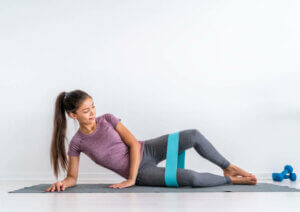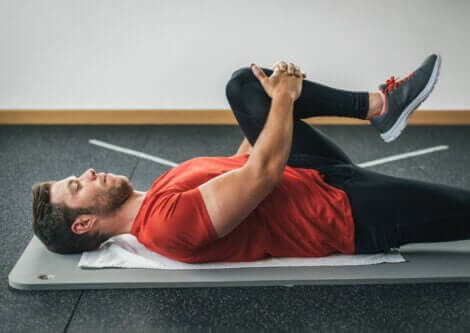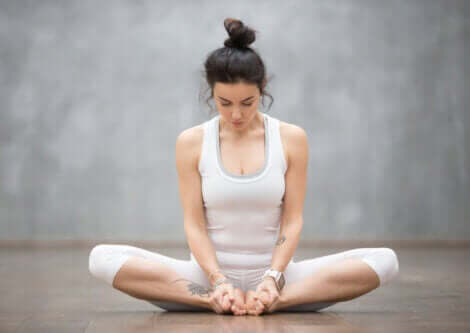How Can You Strengthen Your Hip Flexors?

The hip flexors are a group of muscles located between your abs and your thighs. These muscles don’t just help you to flex your hip joint; they’re also a key contributor to your core’s stability, which affects your whole body. With that in mind, it’s important to strengthen your hip flexors and keep them in tip-top shape.
Do you know much about your hip flexor muscles? What exercises can you do to strengthen them? We’ll explain these points a little further below.
The hip flexor muscles
The psoas muscle and the iliacus muscle are considered the main muscles involved in the job of flexing the hip joint. However, other muscles also help with this function and some experts also consider these as part of the group of hip flexors.
What muscles are those? The sartorius, the rectus femoris, and the tensor facia latae muscles. All of these are the muscles you should work on if you want to strengthen your hip flexors.
How can you strengthen your hip flexors?
The hips are one of the most important areas of the body. Your core is in and around your hips, which is made up of various muscle groups. At your core, your upper body and torso merge with your lower body. A strong and healthy core and surrounding muscles are essential for a healthy life.
Furthermore, having strong hips allows your body to perform basic movements such as walking or running. It also reduces the probability of both muscle and bone injuries. So, what are some recommendations to strengthen your hip flexors? Your focus should be on doing specific physical exercises.
Supported hip flexes
To perform this exercise, you’ll need to start by lying on your back on a comfortable surface, next to a wall. Bend your hips and knees so they’re both at 90 degrees, and support the soles of your feet on the wall or another similar flat surface.

Once you’re in that position, try bringing your knees to your chest, one at a time. Firstly, the right leg, hold it for a few seconds then work your left leg. To help you with this movement you can press your leg against your chest with your hands just below your knee. We recommend doing ten reps on each leg.
Butterfly pose
Sit on the floor in the yoga pose of the butterfly. That is, sit down as if you were going to cross your legs, but put the soles of your feet against each other. Your knees should be as close to the floor as possible. Try to keep your head and back straight and aligned.

Using your hands, grab your ankles and try to bring your feet in as close to your body as you can. This movement will stretch out your hip flexor muscles.
Glute bridge: strengthen your hip flexors
Lie down on your back on a flat surface such as an exercise mat, and put your soles on the floor with your knees bent. Once you’re in that position, slowly raise your hips off the floor until you’re in a straight line from your shoulders to your knees, supporting yourself just with your shoulders, arms, and feet.

Try to hold the position for a few seconds, then slowly lower your hips back to the floor. If you feel up to it, do the bridge with support from your neck too, but be careful not to apply too much pressure.
Hip abductions
A hip abduction is a movement where your leg moves outwards, away from the center of your body. To perform this exercise, you need to lie on one side on your exercise mat, as you can see in the opening photo.
If it’s comfortable, you can bend the bottom leg and keep the other one reasonably straight. From there, slowly lift the top knee, away from your other leg. Focus on controlling the movement. First, do ten reps with one leg, and then change sides and do the other leg.
Strengthen your hip flexors
Strengthening the main muscles that are involved with flexing the hip joints is important for your body’s general stability when it comes to movement. If these muscles aren’t strong and supple, other muscles will step in to help, and the probability of injury will increase.
This is because each muscle group is responsible for some principal and secondary tasks, and shouldn’t have to reach out to supply a deficiency in another muscle group nearby. To keep your body in tip-top shape, make sure you train and strengthen each different area!
The hip flexors are a group of muscles located between your abs and your thighs. These muscles don’t just help you to flex your hip joint; they’re also a key contributor to your core’s stability, which affects your whole body. With that in mind, it’s important to strengthen your hip flexors and keep them in tip-top shape.
Do you know much about your hip flexor muscles? What exercises can you do to strengthen them? We’ll explain these points a little further below.
The hip flexor muscles
The psoas muscle and the iliacus muscle are considered the main muscles involved in the job of flexing the hip joint. However, other muscles also help with this function and some experts also consider these as part of the group of hip flexors.
What muscles are those? The sartorius, the rectus femoris, and the tensor facia latae muscles. All of these are the muscles you should work on if you want to strengthen your hip flexors.
How can you strengthen your hip flexors?
The hips are one of the most important areas of the body. Your core is in and around your hips, which is made up of various muscle groups. At your core, your upper body and torso merge with your lower body. A strong and healthy core and surrounding muscles are essential for a healthy life.
Furthermore, having strong hips allows your body to perform basic movements such as walking or running. It also reduces the probability of both muscle and bone injuries. So, what are some recommendations to strengthen your hip flexors? Your focus should be on doing specific physical exercises.
Supported hip flexes
To perform this exercise, you’ll need to start by lying on your back on a comfortable surface, next to a wall. Bend your hips and knees so they’re both at 90 degrees, and support the soles of your feet on the wall or another similar flat surface.

Once you’re in that position, try bringing your knees to your chest, one at a time. Firstly, the right leg, hold it for a few seconds then work your left leg. To help you with this movement you can press your leg against your chest with your hands just below your knee. We recommend doing ten reps on each leg.
Butterfly pose
Sit on the floor in the yoga pose of the butterfly. That is, sit down as if you were going to cross your legs, but put the soles of your feet against each other. Your knees should be as close to the floor as possible. Try to keep your head and back straight and aligned.

Using your hands, grab your ankles and try to bring your feet in as close to your body as you can. This movement will stretch out your hip flexor muscles.
Glute bridge: strengthen your hip flexors
Lie down on your back on a flat surface such as an exercise mat, and put your soles on the floor with your knees bent. Once you’re in that position, slowly raise your hips off the floor until you’re in a straight line from your shoulders to your knees, supporting yourself just with your shoulders, arms, and feet.

Try to hold the position for a few seconds, then slowly lower your hips back to the floor. If you feel up to it, do the bridge with support from your neck too, but be careful not to apply too much pressure.
Hip abductions
A hip abduction is a movement where your leg moves outwards, away from the center of your body. To perform this exercise, you need to lie on one side on your exercise mat, as you can see in the opening photo.
If it’s comfortable, you can bend the bottom leg and keep the other one reasonably straight. From there, slowly lift the top knee, away from your other leg. Focus on controlling the movement. First, do ten reps with one leg, and then change sides and do the other leg.
Strengthen your hip flexors
Strengthening the main muscles that are involved with flexing the hip joints is important for your body’s general stability when it comes to movement. If these muscles aren’t strong and supple, other muscles will step in to help, and the probability of injury will increase.
This is because each muscle group is responsible for some principal and secondary tasks, and shouldn’t have to reach out to supply a deficiency in another muscle group nearby. To keep your body in tip-top shape, make sure you train and strengthen each different area!
All cited sources were thoroughly reviewed by our team to ensure their quality, reliability, currency, and validity. The bibliography of this article was considered reliable and of academic or scientific accuracy.
- Staugaard-Jones, J. A. (2014). Anatomía del ejercicio y el movimiento. Anatomía Del Ejercicio y Movimiento.
- Giorno, P., & Martínez, L. (2003). Biomecánica de los músculos abdominales y flexores de cadera. Revisión y aportes para la interpretación de ejercicios específicos. PubliCE Standard.
This text is provided for informational purposes only and does not replace consultation with a professional. If in doubt, consult your specialist.








